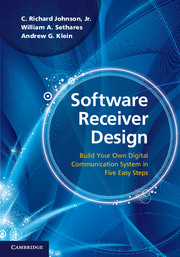3 - The Six Elements
from Step 2 - The Basic Components
Published online by Cambridge University Press: 05 June 2012
Summary
At first glance, block diagrams such as the communication system shown in Figure 2.13 probably appear complex and intimidating. There are so many different blocks and so many unfamiliar names and acronyms! Fortunately, all the blocks can be built from six simple elements:
signal generators such as oscillators, which create sine and cosine waves,
linear time-invariant filters, which augment or diminish the amplitude of particular frequencies or frequency ranges in a signal,
samplers, which change analog (continuous-time) signals into discrete-time signals,
static nonlinearities such as squarers and quantizers, which can add frequency content to a signal,
linear time-varying systems such as mixers that shift frequencies around in useful and understandable ways, and
adaptive elements, which track the desired values of parameters as they slowly change over time.
This section provides a brief overview of these six elements. In doing so, it also reviews some of the key ideas from signals and systems. Later chapters explore how the elements work, how they can be modified to accomplish particular tasks within the communication system, and how they can be combined to create a large variety of blocks such as those that appear in Figure 2.13.
The elements of a communication system have inputs and outputs; the element itself operates on its input signal to create its output signal. The signals that form the inputs and outputs are functions that represent the dependence of some variable of interest (such as a voltage, current, power, air pressure, temperature, etc.) on time.
- Type
- Chapter
- Information
- Software Receiver DesignBuild your Own Digital Communication System in Five Easy Steps, pp. 40 - 57Publisher: Cambridge University PressPrint publication year: 2011



